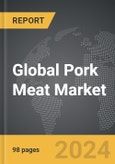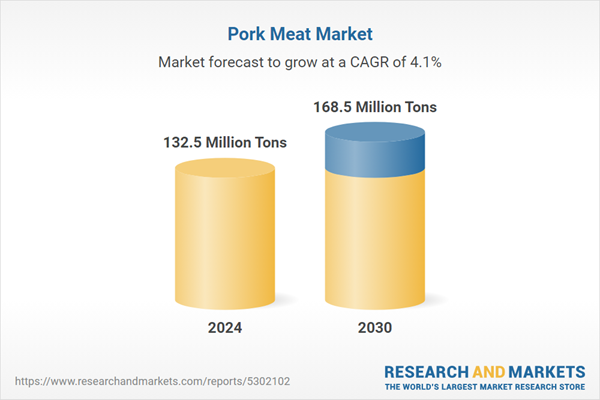The global market for Pork Meat was estimated at 132.5 Million Tons in 2024 and is projected to reach 168.5 Million Tons by 2030, growing at a CAGR of 4.1% from 2024 to 2030. This comprehensive report provides an in-depth analysis of market trends, drivers, and forecasts, helping you make informed business decisions. The report includes the most recent global tariff developments and how they impact the Pork Meat market.
Global Pork Meat Market - Key Trends and Drivers Summarized
Why Is Pork Meat One of the Most Popular Choices in Global Cuisine?
Pork meat has long been a staple in the diets of many cultures, celebrated for its versatility, flavor, and accessibility. For centuries, pork has been consumed in a variety of forms, from fresh cuts to cured products like bacon, ham, and sausages. Its relatively mild flavor allows it to absorb spices, herbs, and marinades easily, making it a favorite in diverse culinary traditions - from Chinese stir-fries and Spanish tapas to American barbecues. Pork is also prized for its different cuts, each offering distinct textures and flavors. Cuts like pork belly, ribs, and tenderloin provide chefs and home cooks alike with options for grilling, roasting, frying, or braising. Nutritionally, pork is a rich source of high-quality protein, essential vitamins, and minerals such as thiamine, niacin, phosphorus, and zinc, which contribute to a balanced diet. Furthermore, the increasing demand for more premium and organic pork products has contributed to its popularity, as consumers are looking for meat that aligns with health-conscious and ethical eating habits. Whether it’s for a family meal or a gourmet experience, pork remains a go-to choice in kitchens worldwide.How Is the Pork Industry Adapting to Modern Consumer Demands and Technological Innovations?
The pork industry has undergone significant transformations in recent years, largely driven by changing consumer preferences and advancements in technology. With growing concerns about sustainability, health, and animal welfare, pork producers are adapting to meet these expectations. The rise of organic and free-range pork products is one such response, catering to consumers who are more conscious of how their food is produced. Free-range pork, in particular, is gaining traction due to its perceived superior quality and ethical production methods. Consumers are increasingly seeking out pork products that are antibiotic-free, hormone-free, and raised in humane conditions. Technological innovations in farming have also played a key role in improving pork production efficiency and sustainability. Precision farming techniques, such as monitoring animal health and diet through advanced sensors and data analytics, help farmers optimize feed use, reduce waste, and ensure better overall animal health. Additionally, innovations in meat processing and packaging are extending the shelf life of pork products while preserving their freshness, ensuring that the industry can meet the growing demand for convenience in today’s fast-paced world. As the pork industry continues to evolve, it is finding ways to balance traditional methods with modern technology to deliver high-quality meat to consumers.What Are the Nutritional Benefits and Quality Considerations of Pork Meat?
Pork meat is not only flavorful but also highly nutritious, offering a range of health benefits when consumed as part of a balanced diet. It is a rich source of high-quality protein, essential for muscle growth and tissue repair. In addition to its protein content, pork is packed with important vitamins and minerals. For example, it is one of the best dietary sources of thiamine (vitamin B1), which is vital for energy metabolism and nerve function. Pork is also high in niacin (vitamin B3), which supports cardiovascular health, and it provides substantial amounts of zinc and iron, both of which are critical for immune function and oxygen transport in the body. Lean cuts of pork, such as pork loin and tenderloin, are lower in fat and calories, making them a healthy option for those looking to manage their weight or reduce saturated fat intake. However, the quality of pork meat can vary based on how the pigs are raised, fed, and processed. Free-range and organic pork, for example, is often viewed as higher quality due to the animals’ better living conditions and natural diet, which can result in meat that is more flavorful and nutritious. As consumers become more informed about the source of their food, they are increasingly prioritizing quality over quantity, seeking out premium pork products that meet their standards for health and sustainability.What Are the Key Growth Drivers in the Pork Meat Market?
The growth in the pork meat market is driven by several factors, all of which reflect shifts in consumer behavior, technological advancements, and global market dynamics. One of the most significant drivers is the increasing demand for protein-rich foods, especially in developing countries where rising incomes are allowing more consumers to incorporate animal protein into their diets. Pork, being one of the most affordable and accessible meats, has seen a surge in consumption in regions like Asia, particularly in China, which is the largest consumer of pork globally. In parallel, the trend toward premiumization in developed markets has driven demand for higher-quality pork products, including organic, free-range, and heritage breeds, as consumers become more discerning about the source and quality of their meat. Technological innovations in farming and processing are also contributing to market growth. Advances in breeding techniques, feed optimization, and disease management have improved pork production efficiency, reducing costs and making pork more widely available. The rise of global trade in pork products has further expanded market reach, with countries like the United States and Brazil becoming major exporters of pork to meet international demand. Furthermore, the increasing popularity of processed pork products, such as bacon, sausages, and ham, has fueled growth, particularly in regions where convenience foods are highly sought after. Lastly, consumer concerns about sustainability and animal welfare are shaping the future of the pork industry, with a growing demand for products that are raised humanely and produced with minimal environmental impact. As these trends continue to evolve, they are expected to keep driving the expansion of the global pork meat market.SCOPE OF STUDY:
The report analyzes the Pork Meat market in terms of units by the following Segments, and Geographic Regions/Countries:- Segments: Product Type (Processed Pork Meat, Fresh Pork Meat); Distribution Channel (Offline, Online)
- Geographic Regions/Countries: World; United States; Canada; Japan; China; Europe (France; Germany; Italy; United Kingdom; Spain; Russia; and Rest of Europe); Asia-Pacific (Australia; India; South Korea; and Rest of Asia-Pacific); Latin America (Argentina; Brazil; Mexico; and Rest of Latin America); Middle East (Iran; Israel; Saudi Arabia; United Arab Emirates; and Rest of Middle East); and Africa.
Key Insights:
- Market Growth: Understand the significant growth trajectory of the Processed Pork Meat segment, which is expected to reach 104.9 Million Tons by 2030 with a CAGR of a 4.4%. The Fresh Pork Meat segment is also set to grow at 3.6% CAGR over the analysis period.
- Regional Analysis: Gain insights into the U.S. market, valued at 35.2 Million Tons in 2024, and China, forecasted to grow at an impressive 6.2% CAGR to reach 35.2 Million Tons by 2030. Discover growth trends in other key regions, including Japan, Canada, Germany, and the Asia-Pacific.
Why You Should Buy This Report:
- Detailed Market Analysis: Access a thorough analysis of the Global Pork Meat Market, covering all major geographic regions and market segments.
- Competitive Insights: Get an overview of the competitive landscape, including the market presence of major players across different geographies.
- Future Trends and Drivers: Understand the key trends and drivers shaping the future of the Global Pork Meat Market.
- Actionable Insights: Benefit from actionable insights that can help you identify new revenue opportunities and make strategic business decisions.
Key Questions Answered:
- How is the Global Pork Meat Market expected to evolve by 2030?
- What are the main drivers and restraints affecting the market?
- Which market segments will grow the most over the forecast period?
- How will market shares for different regions and segments change by 2030?
- Who are the leading players in the market, and what are their prospects?
Report Features:
- Comprehensive Market Data: Independent analysis of annual sales and market forecasts in US$ Million from 2024 to 2030.
- In-Depth Regional Analysis: Detailed insights into key markets, including the U.S., China, Japan, Canada, Europe, Asia-Pacific, Latin America, Middle East, and Africa.
- Company Profiles: Coverage of players such as BRF, Bridgford Foods Corporation, China Yurun Food Group, Danish Crown, Dawn Meats and more.
- Complimentary Updates: Receive free report updates for one year to keep you informed of the latest market developments.
Some of the 52 companies featured in this Pork Meat market report include:
- BRF
- Bridgford Foods Corporation
- China Yurun Food Group
- Danish Crown
- Dawn Meats
- JBS S.A.
- Smithfield Foods
- Tönnies
- Triumph Foods
- Tyson Foods Inc.
- Vion Food Group Ltd.
- WH Group
This edition integrates the latest global trade and economic shifts as of June 2025 into comprehensive market analysis. Key updates include:
- Tariff and Trade Impact: Insights into global tariff negotiations across 180+ countries, with analysis of supply chain turbulence, sourcing disruptions, and geographic realignment. Special focus on 2025 as a pivotal year for trade tensions, including updated perspectives on the Trump-era tariffs.
- Adjusted Forecasts and Analytics: Revised global and regional market forecasts through 2030, incorporating tariff effects, economic uncertainty, and structural changes in globalization. Includes segmentation by product, technology, type, material, distribution channel, application, and end-use, with historical analysis since 2015.
- Strategic Market Dynamics: Evaluation of revised market prospects, regional outlooks, and key economic indicators such as population and urbanization trends.
- Innovation & Technology Trends: Latest developments in product and process innovation, emerging technologies, and key industry drivers shaping the competitive landscape.
- Competitive Intelligence: Updated global market share estimates for 2025, competitive positioning of major players (Strong/Active/Niche/Trivial), and refined focus on leading global brands and core players.
- Expert Insight & Commentary: Strategic analysis from economists, trade experts, and domain specialists to contextualize market shifts and identify emerging opportunities.
- Complimentary Update: Buyers receive a free July 2025 update with finalized tariff impacts, new trade agreement effects, revised projections, and expanded country-level coverage.
Table of Contents
I. METHODOLOGYII. EXECUTIVE SUMMARY2. FOCUS ON SELECT PLAYERSIV. COMPETITION
1. MARKET OVERVIEW
3. MARKET TRENDS & DRIVERS
4. GLOBAL MARKET PERSPECTIVE
III. MARKET ANALYSIS
Companies Mentioned (Partial List)
A selection of companies mentioned in this report includes, but is not limited to:
- BRF
- Bridgford Foods Corporation
- China Yurun Food Group
- Danish Crown
- Dawn Meats
- JBS S.A.
- Smithfield Foods
- Tönnies
- Triumph Foods
- Tyson Foods Inc.
- Vion Food Group Ltd.
- WH Group
Table Information
| Report Attribute | Details |
|---|---|
| No. of Pages | 98 |
| Published | June 2025 |
| Forecast Period | 2024 - 2030 |
| Estimated Market Value in 2024 | 132.5 Million Tons |
| Forecasted Market Value by 2030 | 168.5 Million Tons |
| Compound Annual Growth Rate | 4.1% |
| Regions Covered | Global |








